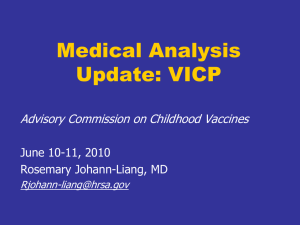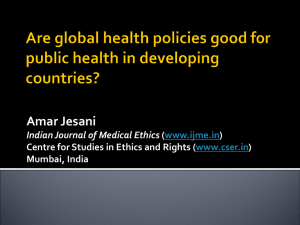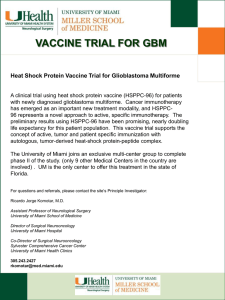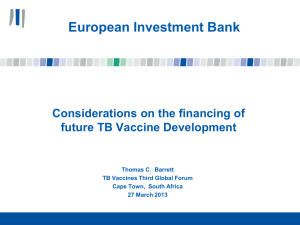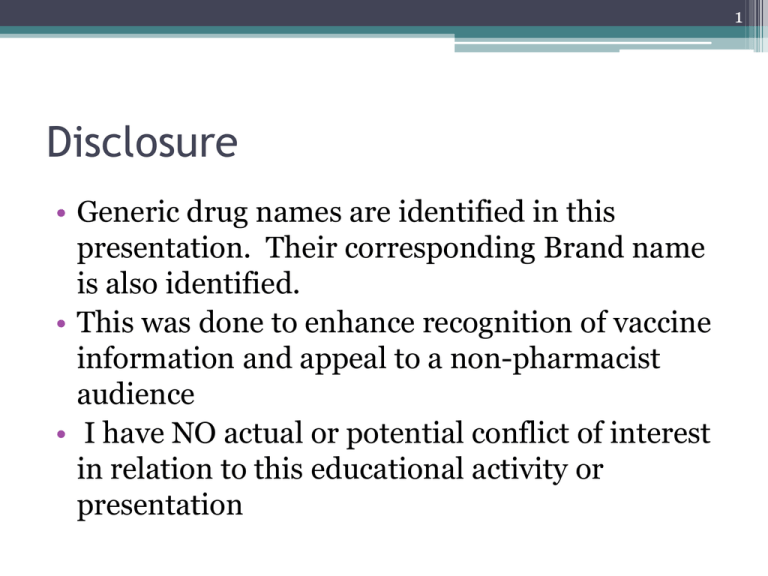
1
Disclosure
• Generic drug names are identified in this
presentation. Their corresponding Brand name
is also identified.
• This was done to enhance recognition of vaccine
information and appeal to a non-pharmacist
audience
• I have NO actual or potential conflict of interest
in relation to this educational activity or
presentation
2
Developing a Preventive Health Care
Plan for a College-Aged Student:
A Pharmacist’s Perspective.
Grace Earl, PharmD, BCPS
University of the Sciences in Philadelphia
Philadelphia College of Pharmacy
g.earl@usp.edu
June 3, 2010
3
Description
• Clinical health initiatives of the Healthy Campus
2010 campaign address the need for primary
prevention in a college-age population. The goal
of the presentation is to develop an age-based
plan for preventive care screenings and drug
therapy interventions. Points on immunization
practices will be emphasized such as
understanding the indications, benefits and risks
of vaccines that impact young men and women’s
health. Barriers may include lack of adequate
insurance coverage.
4
Outline
• Observations on College Health
• Serious Infectious Illnesses: Targets for
Vaccination
• Human Papilloma Virus Vaccine for Women &
Men
• Age-based Preventive Care Plan
5
http://www.cdc.gov/Features/CollegeHealth/
6
http://www.smith.edu/health/quiz.html
7
http://olin.msu.edu/survivalquiz.phpOlin Health Center
8
College Health Quiz Websites
• Center for Disease Control & Prevention
• College Health and Safety Issues Quick Quiz
• http://www.cdc.gov/Features/CollegeHealth/
• Smith College, Northampton, MA
• http://www.smith.edu/health/quiz.html
• Michigan State University
• http://olin.msu.edu/survivalquiz.php
9
Pair and Share Questions
• Refer to your handout for a series of pair and
share questions
• Consult with a partner and discuss your answers
10
Observations on College Health
11
College Student Health Quiz 1
• What condition can run in families, usually
starts between the ages of 15 and 30, and is
experienced by about 20 million people in the
United States?
• From
• Center for Disease Control & Prevention
• College Health and Safety Issues Quick Quiz
http://www.cdc.gov/Features/CollegeHealth/
12
College Student Health Quiz 2
• True or false: Sexually active adolescents and
young adults are at lower risk for getting
sexually transmitted diseases.
http://www.cdc.gov/Features/CollegeHealth/
13
College Student Quiz 3
• Which group of females is most likely to
exhibit disturbances in behaviors such as
anorexia, bulimia, or preoccupation with
dieting, those that are…..
• underweight,
• normal weight, or
• overweight?
• Cohort from Eastern North Carolina University
•Sira N, Pawlak R. Nutr Res Pract 2010; 4(1):36-42
14
College Student Quiz 4
• College students who are knowledgeable
about the dietary nutrition guidelines are more
likely to make healthy food choices when eating
at the dining hall.
Kolodinsky J, et al. J Am Diet Assoc. 2007 Aug;107(8):1409-13.
15
College Student Quiz 5
• Which counter-marketing approach was
more persuasive in changing college students
inclination toward quitting smoking …..
• Ads describing health consequences
• Ads showing tobacco industry manipulation
• Ads demonstrating social norms
Murphy-Hoeffer R, et al. Am J Health Behav 2008;32(6):725-34
16
College Student Quiz 6
• Which group had the greatest influence on
encouraging college age students to receive the
influenza vaccination?
• Media
• Nurses
• Parents
• Physicians
• Student health center
Merrill RM, et al. Med Sci Monit 2010 Feb;16(2):PH29-34.
17
Take Home Message….
18
We need to remember…
• Young people do not recognize their risks
• Healthy appearing students may not have
healthy behaviors
• Knowledge does not equal correct choices
• Linking an unhealthy behavior with a negative
health consequence was shown to be effective in
changing attitudes
• Health professionals can influence student
choices
19
Learning Objectives
•
•
•
•
•
•
•
•
•
•
•
•
•
•
Serious infectious illnesses
- seasonal influenza and H1N1 flu
- meningitis
- tetanus, diphtheria, pertussis
- chicken pox
Human papilloma virus vaccine
- cervical cancer risk factors and causes
- cervical cancer presentation and outcomes
- indications and dosing of human papilloma virus vaccine
- potential adverse reactions
Age-based preventive care plan
- general health (vision, dental)
- blood pressure screening
- bone health (calcium and vitamin D)
- mental health screening (alcohol; depression; smoking)
20
21
What Vaccines Do You Need?
•
•
•
•
•
From CDC Vaccines & Immunizations
Tailors for Gender: male/female
I could become pregnant? I am pregnant now
Do you live in a dormitory?
Assesses Hepatitis A & B risk: sexual contact &
street drug use
• Age 11-18 years or first year college student
living in dormitory (meningitis)
• Have you been vaccinated against chicken pox?
http://www2.cdc.gov/nip/adultImmSched/
22
Factors Impeding Vaccination
Do you have any of these diseases or medical conditions?
• Blood disorder
▫ Anemia
▫ Leukemia
▫ Sickle cell anemia
• Cancer or cancer
treatments
• Weakened immune
system (HIV/AIDS)
• Diabetes
• Heart or lung disease
• Liver or kidney disease
http://www2.cdc.gov/nip/adultImmSched/
23
24
Seasonal Influenza & H1N1 flu
• Emerging epidemiology
• Seasonal vaccine will include H1N1 for 2010-11
• Prevention with oseltamavir (Tamiflu®) and
zanamivir (Relenza®)
Cases
25
Hospitalizations
26
Deaths
27
28
Flu Season 2010-2011
• The H1N1 virus will be included in the seasonal
influenza vaccine
• Announced Feb 22, 2010
• http://www.flu.gov/news/blogs/blog20100222
.html
29
FAQs:
Why do I get the flu when I get the shot?
• 2 week lag time to achieve complete immune
protection
• Those with weak immune system may not be
mount a full immune response
• Circulating viruses do not match the vaccine
virus types
• Change in circulating viruses during season
http://www2c.cdc.gov/podcasts/player.asp?f=11042
30
Influenza resources
• http://www.flu.gov/
• http://www.cdc.gov/flu/weekly/
• Podcasts at CDC
• http://www2c.cdc.gov/podcasts/browse.asp\
31
Meningitis
•
•
•
•
•
•
Signs and Symptoms
Sudden onset of fever, headache, and stiff neck
Photophobia (sensitivity to light)
Confusion
Nausea
Vomiting
http://www.cdc.gov/meningitis/about/symptoms.html
http://www.nlm.nih.gov/medlineplus/ency/imagepages/2938.htm
32
Meningitis Complications
• Can be rapidly fatal
• Cranial nerve palsy
• Cerebral edema
• Mental retardation
• Deafness
http://www.who.int/mediacentre/factsheets/fs141/en/
33
Meningitis Prevention
• Menactra – intramuscular injection
▫ Quadrivalent conjugate, Ages 2 to 55 years
• Menveo – intramuscular injection (NEW)
▫ Ages 11 to 55 years
▫ Quadrivalent oligosaccharide conjugate
• Menomune – subcutaneous injection
▫ Ages 2 and older
▫ Quadrivalent polysaccharide vaccine
▫ A, C, W-135 and Y
34
Meningitis Candidates
• Pre-teens & college freshman
• Institutionalized – colleges
• Individuals with sickle cell anemia or
splenectomy
•
•
•
•
Travelers
Military recruits
Hajj
Sub-Saharan Africa (June to December)
35
Meningitis Exposure
• Treat close contacts with antibiotic prophylaxis
•
•
•
•
Rifampin
Ciprofloxacin (quinolone)
Ofloxacin (quinolone)
Azithromycin (macrolide)
36
Whooping Cough
http://www.topnews.in/health/files/Whooping-Cough.jpg
37
Tetanus, Diphtheria, Pertussis
• Tetanus: Lockjaw
• Diptheria: mucous coating in back of throat
• Pertussis: Whooping Cough
• Link – the sounds of whooping cough
http://www.soundsofpertussis.com/mediaplayer.html
38
Pertussis Outbreaks
• National Notifiable Diseases Surveillance
System
• Endemic – occurs every 3-5 years
• Last outbreak in 2005 with 25,616 reported
cases including children and adults
• Vaccinate infants at 2, 4, & 6 months
• Fourth vaccine at 15-18 months
• Fifth vaccine when they enter school 4-6 years
39
Tdap vs. Td vaccines
• Td: tetanus & diptheria
• Tdap: tetanus, diptheria & acellular pertussis
• Td: given every 10 years, or after a cut or injury
to protect against tetanus
• Tdap: licensed in 2005
• Adults 19 to 65: substitute Tdap for the next
booster dose
• Indicated for 1 lifetime dose to prevent pertussis
•
40
Chicken Pox
• Varicella Zoster Virus (VZV)
• Complications: Cerebellar ataxia, encephalitis,
pneumonia due to secondary bacterial infection
• Maternal Transmission
• During 1st and early 2nd trimester
• Fetal death or skin scarring, eye abnormalities,
limb hypoplasia
• Congenital Varicella Syndrome (CNS damage)
http://www.nlm.nih.gov/medlineplus/images/chickenpox.jpg
41
Chicken Pox
•
•
•
•
•
•
Risk groups
Immunocompromised individuals
Taking steroids or immunosuppressants
Infants, children, adolescents
Chronic diseases
Pregnant women
42
Chicken Pox
• Contagious Period
• 1-2 days before rash appears
up to crusting of lesions
• Return to school when vesicles have crusted
• At risk individuals
▫ Antiviral drug
▫ Oral acyclovir 80 mg/kg in 4 divided doses
▫ Treat for 5 days
http://www.nlm.nih.gov/medlineplus/ency/images/ency/fullsize/1301.jpg
43
Chicken Pox
• Catch up vaccination
▫ Anyone who has not had chicken pox > 12 months
of age
▫ No evidence of immunity
▫ Varivax®
▫ Live attenuated vaccine
44
Chicken Pox
• Evidence of immunity- required for entry
to college
• Documentation of age-appropriate vaccinations
• Laboratory testing
• Birth in United States before 1980 (unless you
are in at at risk group)
• Verification by a health care professional that
individual had diagnosis of chicken pox or
shingles
45
German Measles
http://www.nlm.nih.gov/medlineplus/ency/imagepages/2943.htm
46
Measles, Mumps, Rubella
• Measles (Rubeola): fever, cough, runny nose,
conjunctivitis
• Mumps: cough, sneezing, swollen salivary
glands, fever
• Rubella (German Measles): maculopapular rash,
onset of rash is 2 weeks after exposure
▫ Maternal exposure: Congenital Rubella syndrome
47
Rubella
• No longer endemic
• 15 cases reported per year
• At risk
▫ Individuals born outside the United States
▫ Individuals from areas with low vaccine usage
▫ Post pubertal men and women such as military
recruits, college age students
▫ Health care professionals
48
Measles, Mumps, Rubella
•
•
•
•
Require on entry to college
Proof of 2 vaccinations
Titers demonstrating immunity
Proof of physician diagnosed illness
http://www.cdc.gov/vaccines/vpd-vac/combo-vaccines/mmr/faqs-nipinfo-mmr.htm
49
Vaccine Cases
4 scenarios
50
Vaccine Mini-case #1
• A student enrolled in a health care professional
program will be starting a rotation at a hospital.
• They send in evidence from their physician that
they had chicken pox as a child.
• The practice site refuses this form of
documentation and requires either titers or
vaccination as proof.
• Why?
51
Vaccine Mini-case #2
• A student is injured in a community service
project. While involving with planting new
trees, they cut their hand.
• Which vaccine should be administered?
52
Vaccine Mini-Case #3
• During an H1N1 mass vaccination program, one
of the students returns 20 minutes after
administration of the vaccine with hives.
• What action do you take?
53
Vaccine Adverse Event Reporting
• VAERS
• 1-800-822-7967
• http://vaers.hhs.gov
54
Vaccine Mini-Case #4
• A young person has Rheumatoid Arthritis and
hates “shots.” She asks if she can receive the
seasonal influenza live attenuated vaccine that is
administered intranasally.
• What advice can you offer?
55
Immunosuppressant Drugs
•
•
•
•
•
•
Use in
Asthma
Inflammatory bowel disease
Rheumatoid athritis
Allergic Reactions
Nephrotic Syndrome
Oral Steroids
• Prednisone (Deltasone®)
• Methylprednisone (Medrol
Dosepak®)
• Use in
• Rheumatoid Arthritis
• Inflammatory Bowel Disease
• Tumor Necrosis
Factor (TNF)
inhibitors
• Adalimumab -Humira®
• Certolizumab –Cimzia®
• Etanercept –Enbrel®
• Golimumab –Simponi®
• Infliximabe -Remicade®
56
Immunosuppressants for
Rheumatoid Arthritis
•
•
•
•
Azathioprine
Mercaptopurine
Methotrexate
Cyclosporine - Neoral ®
• Natalizumab -Tysabri ®
▫ A monoclonal antibody that attacks a molecular on
leukocytes
57
Learning Objectives
•
•
•
•
•
•
•
•
•
•
•
•
•
•
Serious infectious illnesses
- seasonal influenza and H1N1 flu
- meningitis
- tetanus, diphtheria, pertussis
- chicken pox
Human papilloma virus vaccine
- cervical cancer risk factors and causes
- cervical cancer presentation and outcomes
- indications and dosing of human papilloma virus vaccine
- potential adverse reactions
Age-based preventive care plan
- general health (vision, dental)
- blood pressure screening
- bone health (calcium and vitamin D)
- mental health screening (alcohol; depression; smoking)
58
Human Papilloma Virus
• Most common sexually transmitted infection
• Most often it is asymptomatic
• Transmitted by vaginal, anal, oral, and genitalto-genital contact
• 50% of men & women acquire HPV
• 70% of cervical cancers caused by HPV types 16
and 18
• HPV can also affect the mouth and throat
59
Prevalence of HPV Infection 2003-4
http://www.cdc.gov/mmwr/preview
/mmwrhtml/mm5633a5.htm
60
Human Papilloma Virus Vaccine
• Human Papilloma Virus Quadrivalent
Vaccine, Recombinant
• Types 6, 11, 16 and 18
• Gardasil®
http://origin.cdc.gov/std/hpv/st
dfact-hpv-vaccine-hcp.htm
• Human Papilloma Virus Bivalent Vaccine,
Recombinant
• Types 16 and 18
• (Cerevix®)
61
Human Papilloma Virus Vaccine
• Indications in females
• Quadrivalent HPV vaccine
• Females ages 11 and 12 years (or ages 13 to 26
years if missed at younger age)
• Bivalent HPV vaccine
• Females ages 10 through 25 years
• Provisional recommendation in males
• Prevent genital warts
• Boys and young men ages 9 to 26 years
62
HPV and Cervical Cancer Prevention
• HPV vaccine
• Pap test annually
▫ Begins 3 years after sexual intercourse
(but no later than age 21 years)
▫ Conventional Pap test yearly, or
▫ Liquid Pap test every 2 years
63
Human Papilloma Virus Vaccine
•
•
•
•
25% experience injection site reaction
Syncope
Majority self-limiting (fever)
Serious
▫ Guillain-Barre
▫ Blood clots (risk factor: oral contraceptives)
• Other issues
• Insurance coverage gaps
64
HPV Mini-cases
• 4 mini-cases
http://www.cdc.gov/std/hpv/common-questions.htm
65
HPV – Mini-case #1
• A 21 year-old female has received 3 doses of the
quadrivalent HPV vaccine.
• Does this change your preventive care strategy
on cervical cancer screening?
66
HPV- Mini-case #2
• A 28 year-old sexually active female student asks
if she should get the HPV vaccine.
• What advice can you offer?
67
HPV – Mini-case #3
• You are asked to participate in a college health
fair.
• How do you prepare to answer this question:
• What is the best method for preventing
transmission of HPV infection?
68
HPV – Mini-case #4
• The administrative director and pharmacist are
discussing the pharmacy formulary for vaccines.
• What factors would be considered when
evaluating the HPV-quadrivalent and HPVbivalent vaccine?
69
HPV – Mini-case #4
HPV Quadrivalent
HPVBivalent
Yeast
Latex
Coverage
4 viral types
2 viral types
Approval by age
11-26 years
10-25 years
Use in boys and
young men
Yes
No
Hypersensitivity
cautions
70
Learning Objectives
•
•
•
•
•
•
•
•
•
•
•
•
•
•
Serious infectious illnesses
- seasonal influenza and H1N1 flu
- meningitis
- tetanus, diphtheria, pertussis
- chicken pox
Human papilloma virus vaccine
- cervical cancer risk factors and causes
- cervical cancer presentation and outcomes
- indications and dosing of human papilloma virus vaccine
- potential adverse reactions
Age-based preventive care plan
- general health (vision, dental)
- blood pressure screening
- bone health (calcium and vitamin D)
- mental health screening (alcohol; depression; smoking)
71
Illness-Wellness Continuum
John W. Travis, MD
http://www.thewellspring.com/template_images/IllnessWellnessContinuumW.jpg
72
General Health
Vision
The American
Optometric
Association
Ages 18-64 years;
every 2 years
Hearing
American SpeechLanguage-Hearing
Association
Ages 18-49 years:
every 10 years
≥ 65 years: annually
≥50 years: every 3
years
Drug-induced causes
of vision changes:
digoxin for heart
failure: halos around
object or discoloration
(red, yellow, green,
blue, changes)
Drug-induced:
diuretics, amino
glycoside antibiotics,
high dose aspirin
causes tinnitus.
73
Hypertension
•
http://www.nlm.nih.gov/medlineplus/ency/images/ency/fullsize/18166.jpg
www.americanheart.org
74
Percent of Total Deaths
Percent of Total Deaths
40
35
30
36.7
34.2
24.4
25
20
15
10
21.7
6.3
5.5
5
0
A
B
C
D
2.9
E
Males
A Total CVD
B Cancer
C Accidents
A
B
6.0
4.4
3.3
D
F
C
Females
D Chronic Lower Respiratory Diseases
E Diabetes Mellitus
F Alzheimer’s Disease
CVD and other major causes of death for white males and
females (United States: 2005). Source: NCHS.
75
Percent (%)
Percentage of Total Deaths by Age group (US 2006)
50
45
40
35
30
25
20
15
10
5
0
15-19 yrs
20-24 yrs
A
A Accidents
B
C
E
F
D Cancer
B AssaultE Cardiovascular disease
C Suicide
D
F Cerebrovascular
http://www.cdc.gov/
nchs/data/nvsr/nvsr5
8/nvsr58_14.pdf
76
Blood pressure
Screening
Blood pressure
JNC 7
Screening every 2
years with BP <
120/80 mm Hg
Onset: starting at age
18 years - all adults
Screening every year
with SBP of 120-139
mm Hg or DBP of 8090 mm Hg.
JNC 7: The Joint National Committee on Prevention, Detection, Evaluation, and
Treatment of High Blood Pressure (JNC 7)
77
Bone health
Screening: dual energy x-ray
absorptiometry (DEXA) scan
DEXA scan
All men age 70 and
over &
National Osteoporosis all women age 65 and
older
Foundation
Those with risk
factors: cigarette
smoking, excessive
alcohol use, diet low in
calcium, use of certain
medication such as
steroids, broken bone
http://www.womenshealth.gov/minority/africanamerican/images/woman.jpg Accessed 2009 Sept 10
78
Bone health:
Nutritional Supplements
National Osteoporosis
Foundation 2008
www.nof.org
Calcium:
1000 mg age 21-50 yrs:
1200 mg age > 50 yrs
Calcium sources:
milk, yogurt,
cheese, fortified
juices, soybean,
tofu, baked beans,
broccoli, salmon
Daily vitamins D2 or D3.
400-800 IU age 21-50
yrs
800-1000 IU age > 50
yrs
Vitamin D sources:
fortified milk, egg
yolks, saltwater
fish, liver
79
www.nof.org
80
Mental Health: Depression
• Screening: Recommended that screening for all adults >18
years of age is effective.
• Screening Tools: Beck Depression Inventory, Zung SelfAssessment Depression Scale. General Health
Questionnaire.
• Sample questions:
Over the past 2 weeks, have you felt down, depressed, or
hopeless?
Over the past 2 weeks, have you felt little interest or
pleasure in doing things?
• Recommendation by: United States Preventive Services
Task Force
http://www.ahrq.gov/clinic/uspstf/uspsaddepr.htm
81
Drugs causing Depression
• Substance abuse:
▫ Alcohol, Cocaine, Amphetamines
•
•
•
•
•
Inflammatory conditions: corticosteroids
Oral contraceptives
Drugs for migraines: Barbituates - Fioricet®
Persistent Nausea – metoclopramide -Reglan®
For cancers (HIV Kaposi’s Sarcoma, Solid
tumors and leukemia): interferon – Roferon A ®
and Intron A ®
Merck Manuel of Diagnosis and Therapy, 18th edition, 2006, on Stat!Ref
82
Smoking cessation: 5 A’s
Ask about tobacco use: Identify & document tobacco use status at
every visit
Advise to quit: In a clear, strong, & personalized manner, urge every
smoker to quit.
Assess willingness to make a quit attempt. Is the tobacco user
willing to make a quit attempt at this time?
Assist in quit attempt: for the patient willing to make a quit attempt,
offer medication & provide or refer for counseling or additional
treatment
Arrange follow up: for the patient willing to make a quit attempt,
arrange for follow up contacts, beginning within the first week after the
quit date.
www.rxforchange.ucsf.edu/
http://www.ahrq.gov/clinic/uspstf/uspstbac2.htm#summary
83
Cost Analysis
Drug
Cost per
Varenicline
Chantix ®
$445.50 – 12 weeks
Bupropion SR 150
mg – generic
2 tabs daily
$296.00 – 12 weeks
Transdermal
Nicotine Patch
Nicoderm CQ ®
$161.97 – 6 weeks
Cigarettes (1
pack/day)
$588.00
www.drugstore.com Accessed: 2010 May 25
Cost per year
1 continuing & 1
starting pack
$148.50 ea
$2555.00
84
Nicotine Replacement Products
Pharmacotherapy
Nicotine transdermal
patch (Nicoderm CQ,
Nicotrol)
Dose
Administration
7, 14, 21 mg/24h or
5, 10, 15 mg/16h
OTC
Highest dose daily for 6
wk, then taper
Nicotine gum
(Nicorette)
2, 4 mg OTC
Nicotine lozenges
(Commit)
2, 4 mg OTC
Nicotine inhaler
(Nicotrol)
Nicotine nasal spray
(Nicotrol NS)
One piece every 1-2 hr
for 6 wk, then taper
2 mg per cartridge
Rx
6 to 16 cartridges
inhaled daily for
6 -12 wk, then taper
0.5 mg per spray Rx
1-2 sprays in each
nostril every hour for 8
85
Alcohol Screening
CAGE: Screening Tools for Alcohol Abuse
Have you ever felt the need to:
Cut down on drinking?
Have you ever felt:
Annoyed by criticism of you drinking?
Have you ever felt:
Guilty about your drinking?
Have you ever taken a morning:
Eye opener?
Two answers of “yes” are considered to be a positive prevention.
In: Current Medical Diagnosis and Treatment. 48th ed. New York: Lange.
in: Stat!Ref.
http://pubs.niaaa.nih.gov/publications/arh28-2/94-104.htm
Available
86
Preventive Care Plan
Jacy is 22 year-old female and is returning to
college for the Fall semester. She is concerned
about all of the media reports on the influenza
epidemic. She is working as a pharmacy
technician. She met with her family doctor,
dentist, and gynecologist for check-ups this year.
She does not have any chronic medical
problems.
Develop a Preventive Intervention Plan for Jacy.
87
Mini-case #1: Jacy
•
•
•
•
•
•
•
•
•
•
•
•
Primary Prevention:
Weight yearly
Vision every 2 years
Hearing every 10 years
Calcium 1000 mg po daily
Vitamin D 400-800 IU daily
If not sexually active: Pap test at age 21 y
HPV vaccine up to age 26 years if not sexually active
BP every 2 years
Seasonal influenza vaccine for Fall 2010 (includes H1N1)
Screen for smoking at every visit
Screen for alcohol in primary care (pregnant, prior
history of alcohol misuse)
88
Thanks to:
• Trent Towne, PharmD, Assistant Professor, Dept
of Pharmacy Practice & Administration,
Philadelphia College of Pharmacy
• Bonnie Packer, RN, Nurse Manager, Student
Health Services, University of the Sciences in
Philadelphia
• Paul Furtaw, PsyD, Director of Student Health
and Counseling, University of the Sciences in
Philadelphia
89
National Dog Bite Prevention Day
http://www.dogtipper.com/tip/2009/05/preventing-meter-readerbites.html Accessed 2010 May 13



